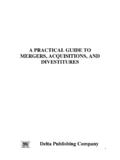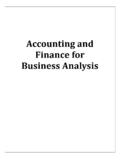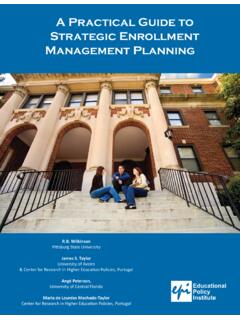Transcription of A PRACTICAL GUIDE TO MERGERS, ACQUISITIONS, AND …
1 1 A PRACTICAL GUIDE TO MERGERS, ACQUISITIONS, AND DIVESTITURES Delta Publishing Company 2 Copyright 2009 by DELTA PUBLISHING COMPANY Box 5332, Los Alamitos, CA 90721-5332 All rights reserved. No part of this course may be reproduced in any form or by any means, without permission in writing from the publisher. 3 TABLE OF CONTENTS CHAPTER 1 MERGERS AND ACQUISITIONS CHAPTER 2 DIVESTITURE GLOSSARY 1 CHAPTER 1 MERGERS AND ACQUISITIONS LEARNING OBJECTIVES: After studying this chapter you will be able to: 1. Define mergers. 2. List twelve conditions required to merge. 3. Define and perform due diligence. 4. Identify information to consider before "doing a deal 5. Describe antitrust guidelines 6. Explain M & A percent rules. 7. Plan for mergers and acquisitions. 8. Decide on acquisition terms. 9. List factors in determining a price. 10. Describe grading criteria. 11. Summarize acquisition strategy and process.
2 12. Finance the merger. 13. Use capital budgeting techniques for M&A analysis. 14. Explain the effect of merger on earnings per share and Market price per share. 15. Describe the risk of the acquisition. 16. Explain the methods of hostile takeover bids. 17. Outline SEC filing requirements and tax considerations 18. Enumerate defensive measures by targeted company. 19. Determine the value of a targeted company. 20. Describe accounting, reporting and disclosures for business combinations 21. Discuss the importance of corporate development officers (CDOs) M&A teams For years, academic studies maintained mergers and acquisition (M&A) deals destroyed shareholder value. In 2006, however, businesses around the globe bought (and therefore sold) more companies for more money than ever. It was not just a year of record merger volume - more than $3,800 billions - but also a merger market with unprecedented breadth, across geographies and industries. M&A transactions in the current merger cycle differ in significant ways from those of the 1990s, and this probably explains why so much value has recently been created.
3 Specifically, this current merger boom is characterized by Horizontal consolidation with significant potential for cost synergies. The use by acquirers of existing cash and borrowed money (after-tax cost) to purchase the (relatively higher cost) equity of acquired companies. Much lower acquisition premiums being initially paid. Mergers and acquisitions can result in new organizations whose financial and strategic options are much improved. They are driven by globalization, a long-term market, various barriers to growth, which make M&As a valuable tool by which companies can quickly attempt to increase revenue. 2 This chapter discusses all facets of M&As including deciding on terms, key factors to consider, pros and cons of mergers, types of arrangements, evaluative criteria, valuation methods, financial effects of the merger, holding companies, takeover bids, SEC filing requirements, accounting and reporting requirements for business combinations, and financial analysis of combinations.
4 External growth occurs when a business purchases the existing assets of another entity through a merger. You are often required to appraise the suitability of a potential merger as well as participate in negotiations. Besides the growth aspect, a merger may reduce risk through diversification. The three common ways of joining two or more companies are a merger, consolidation, or a holding company. In a merger, two or more companies are combined into one, where only the acquiring company retains its identity. Generally, the larger of the two companies is the acquirer. A merger is a business combination in which the acquiring firm absorbs a second firm, and the acquiring firm remains in business as a combination of the two merged firms. The acquiring firm usually maintains its name and identity. Mergers are legally straightforward because there is usually a single bidder and payment is made primarily with stock. The shareholders of each merging firm involved are required to vote to approve the merger.
5 However, merger of the operations of two firms may ultimately result from an acquisition of stock. With a consolidation, two or more companies combine to create a new company. None of the consolidation firms legally survive. For example, companies A and B give all their assets, liabilities, and stock to the new company, C, in return for C s stock, bonds, or cash. A holding company possesses voting control of one or more other companies. The holding company comprises a group of businesses, each operating as a separate entity. By possessing more than 50% of the voting rights through common stock, the holding company has effective control of another company with a smaller percent of ownership. Depending on the intent of the combination, there are three common ways in which businesses get together so as to obtain advantages in their markets. They are: Vertical merger. This occurs when a company combines with a supplier or customer. An example is when a wholesaler combines with retailers.
6 Horizontal merger. This occurs when two companies in a similar business combine. An example is the combining of two airlines. Conglomerate merger. This occurs when two companies in unrelated industries combine, such as where an electronics company joins with an insurance company. MERGERS Outstanding planning and execution are essential for a successful merger. Integration is reached only after mapping the process and issues of the companies to be merged. Even then just 23% of all acquisitions earn their cost of capital. When M&A deals are announced, a company s stock price rises only 30% of the time. In acquired companies, 47% of executives leave within the first year, and 75% leave within the first three years. Synergies projected for 3M&A deals are not achieved 70% of the time. Productivity of merged companies can be affected by up to 50% in the first year and financial performance of newly merged companies is often lacking. While there is no set formula to guarantee a successful merger, in order to minimize the negative impacts previously discussed, a map of M&A process and issues should be developed.
7 The following steps describe the model of process and issues: Step 1: Formulate This stage involves the organization setting out its business objectives and growth strategy in a clear, rational, and data-oriented way. Companies should avoid vague and general objectives. Instead, a specific criteria should be formulated based on the objectives that have been determined and on a strategy of growth through acquisition. These criteria should be expressed in terms of goals like market share, geographic access, new products or technologies, and general amounts for financial synergy. The organization should evaluate the ideal target company based on factors such as the following: What type of cost structure does the ideal target have? What market channels would this target provide? What kinds of organizational competence and capabilities would provide maximum leverage and the greatest number of synergies? Are there strategic customer accounts or market segments to be gained?
8 In what global regions or countries can we build additional capacity through this target? What is the optimum capital structure? What are the sources for new acquisitions? Will the ideal targets be operated as independent holdings, or does the organization intend to integrate the business partly or fully into its operations? If joint venture structures are to be used what level of involvement is desired by the parent company? Step 2: Locate After the strategic template has been set in Step 1, the search for desirable target companies should become more focused on financing an operational analysis. These initial parameters, terms, and conditions are defined and ultimately submitted as part of a letter of intent. These letters describe the desired objectives and give an overview of the proposed financial and operational aspects of the transaction. They also include specific details on items like the assets and business units involved, the equity positions of the parent companies, the assumption-of-debt requirements, inter-company supply agreements, employee liabilities, taxes, technology transfer, indemnification, public announcements, and other essential terms and conditions.
9 Additional agreements outside the letter of intent should be made about the following issues. In the case of a joint venture arrangement, the governance structure of the partnership and specific issues for approval need to be agreed upon. The overall process to be used for determining top-level organizational structure and staffing decisions should also be agreed upon. Agreement on the integration process to be used, including mutual participation, formation of key task forces, planning phases, and leadership roles should take place at this point. Another additional agreement that should be made at this point is high-level reconciliation 4of major discrepancies regarding executive compensation, employee benefits, and incentive compensation plans. Once a consensus is made regarding these agreements, companies can move to Step 3. Step 3: Investigate The third step in the model relies on exploring all facets of the target company before finalizing a definitive agreement.
10 Due diligence must be exercised in the financial, operational, legal, environmental, cultural, and strategic areas. Key findings should be summarized for executive review, and all potential merger problems should be identified. Due diligence findings are used to set negotiating parameters, determine bid prices, and provide the basis for initial integration recommendations. Due diligence is particularly important in light of recent felonious accounting practices. Had Enron or WorldCom been acquired without due diligence, the newly formed company would probably not have uncovered accounting irregularities until months after the acquisition. This could cost billions in market capitalization. There are other areas where due diligence is helpful with assessing risk. The following are key areas to focus due diligence. Market. How large is the target s market? How fast are specific segments growing? Are there threats from substitute technologies or products?















